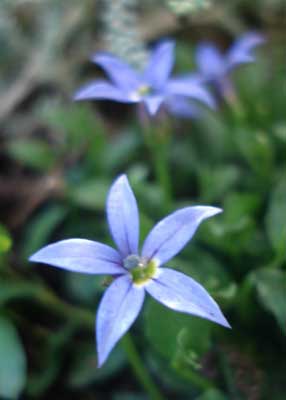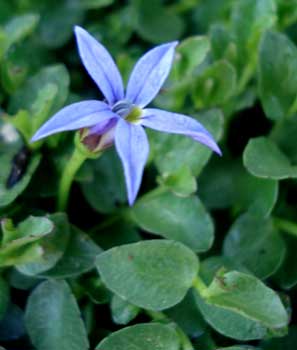
'County Park'
Blue Star Pratia
"Gardening is a symbol of the spiritual path."
-Larry Dossey,
1997
Obtained cheaply in a flat from Home Depot, Pratia pedunculata 'County Park' is an intensely blue-starred tiny groundcover, a Heritage Perennial named after the County Park Nursery, sometimes listed incorrectely as 'Kelsey Blue.' The June photos on this page are extreme close-ups; the blooms are exceedingly small.1997
It's long-blooming through most of summer & part of autumn. In spring it can be divided into tiny plugs of about an inch & a half each to spread them out & speed up their ability to cover a large area.
 Its current scientific name is P pedunculata, but it has gone by other names, including Pratia angulata, Laurentia fluviatilis, Lobelia fluviatilis, & Isotoma fluviatilis. The name Isotoma fluviatilis was for a while applied to a look-alike native to New Zealand, but that has become regarded as an "allied genera," reassigned the same genera as P. angulata.
Its current scientific name is P pedunculata, but it has gone by other names, including Pratia angulata, Laurentia fluviatilis, Lobelia fluviatilis, & Isotoma fluviatilis. The name Isotoma fluviatilis was for a while applied to a look-alike native to New Zealand, but that has become regarded as an "allied genera," reassigned the same genera as P. angulata.There's a great deal of confusion in labeling at nurseries, because of the plethora of scientific names for two pratias which are such similar plants, both in mass production. But the most commonly offered cultivors should be corrected (until taxonomists change their mind again) as Pratia pendunculata 'County Park' from Australia, & Pratia angulata 'Treadwellii' from New Zealand.
The Treadwell Pratia is such a pale blue it's almost white & barely justifies its common name Blue Star Creeper, hence sometimes called White Star Creeper; but 'County Park' is truly blue.
Periennial in zones 7 & 8, it grows rapidly enough to make a good annual down to zone 5. Here on Puget Sound, the evergreen or semi-evergreen foliage can hump up to six inches but may remain two or three inches high. It's a rapidly spreading groundcover in full sun with moist well-draining soil, covered over with a sprinkling of slender-petalled blue stars of a half-inch each.
It's not especially drought hardy in full sun & will become shrivelled if allowed to be dry. But it will also grow under shrubs with indirect light, even right up to the trunks of rhododendrons, & in such protected locations needs a lot less water, while flowering only slightly less extravagantly. However, it does not like to be wet long at a time, eitehr, & does require good drainage.
It's commonly used in containers where it fills the bottom of the pot without interfering with a larger display plant. It's also used as a lawn substitute, but primarily the kind of lawn that is not rough-housed on or much trod upon. It'll recover from being walked on but it just won't look so great from such abuse.
It is also grown between pavers, but isn't honestly as treadable as advertised. So the ground should be "trenched" between pavers so that the pratia is well rooted below the pavers' top edge, & where it won't really get walked on directly.
Such between-paver groundcovers as Irish Moss (Sagina subulata) will spread over the surface of the stones & can be troublesome keeping the stones properly visible, but Blue Star Creeper is much less inclined to grow over stone, because it "creeps" along by means of tiny white runners just under the soil & there'd have to be plenty of soil on the pavers for it to begin covering them up. Thus it's also good in a regularly watered rock garden, wherever it is preferred the rocks not become hidden under the spreading plants.